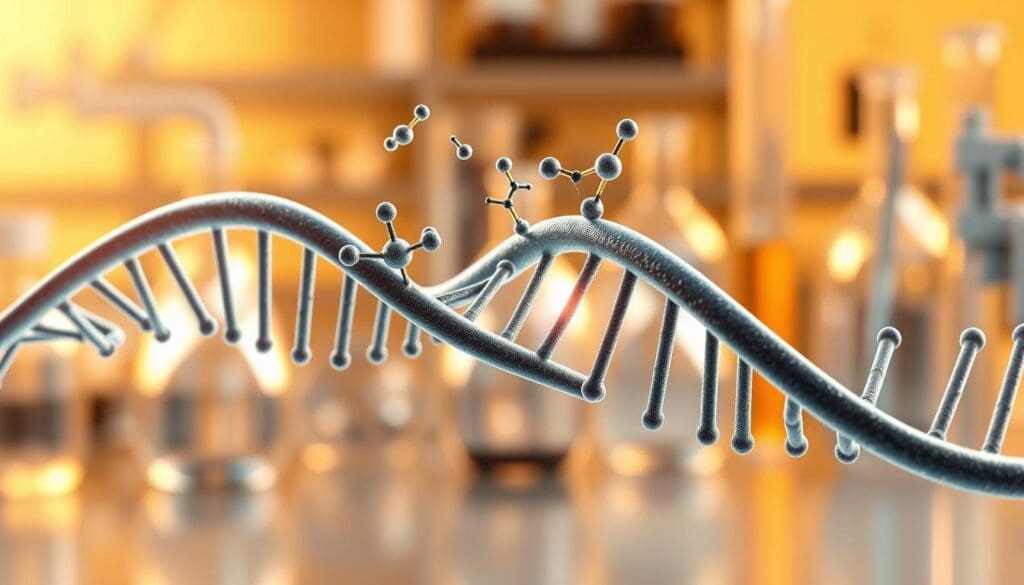Last Updated on November 27, 2025 by Bilal Hasdemir

At Liv Hospital, we know how vital effective chemotherapy treatments are. Alkylating antineoplastic drugs are key in cancer therapy. They damage DNA in fast-growing cells, stopping cancer from spreading.
We’ll look at how these chemotherapy drugs work. They add alkyl groups to DNA, causing cells to die. This is essential in fighting different cancers. In this article, we’ll cover 12 important examples of these drugs and their role in cancer battles.
Key Takeaways
- Alkylating chemotherapy drugs damage DNA in cancer cells, disrupting their growth.
- These drugs are a cornerstone of cancer therapy, used to treat various types of cancer.
- The mechanism of action involves adding alkyl groups to DNA, leading to cell death.
- 12 key examples of these drugs will be discussed, highlighting their importance in cancer treatment.
- Effective chemotherapy treatments are essential for better patient outcomes.
Understanding Alkylating Agents in Cancer Treatment
Alkylating agents have been key in fighting cancer for many years. They provide many treatment choices. We’ll look at what they are, how they’re classified, and their role in cancer therapy.
Definition and Classification of Alkylating Antineoplastic Agents
Alkylating antineoplastic agents are a type of chemotherapy drug. They attach an alkyl group to cancer cells’ DNA. This stops the cells from copying themselves and leads to their death.
These drugs are sorted into groups based on their makeup and how they work. The main types are nitrogen mustards, nitrosoureas, and alkyl sulfonates.
| Category | Examples | Mechanism of Action |
|---|---|---|
| Nitrogen Mustards | Cyclophosphamide, Melphalan | Cross-linking DNA strands |
| Nitrosoureas | Carmustine, Lomustine | Alkylating DNA, inhibiting repair |
Historical Development in Cancer Therapy
The history of alkylating agents starts with the early days of chemotherapy. Nitrogen mustard was one of the first used. These compounds were first linked to chemical warfare.
Over time, we’ve learned more about how they work. We’ve also made new versions that are more effective and safer.
Today, alkylating agents are a big part of cancer treatment. They offer effective ways to fight many types of cancer.
How Alkylating Agents Work in Chemotherapy
Alkylating agents are key in chemotherapy. They damage cancer cells’ DNA to stop them from growing. We’ll see how they disrupt DNA replication, causing cells to die.
DNA Alkylation Mechanism
Alkylating agents add alkyl groups to DNA, a process called DNA alkylation. This action hinders DNA replication and transcription. These are vital for cell division and growth.
By alkylating DNA, these agents stop cancer cells from copying themselves. This leads to cell death. They create cross-links between DNA strands. This makes it hard for the cell to fix or copy its DNA.
Cell Cycle Effects and Cancer Cell Targeting
Alkylating agents target fast-growing cells, like most cancer cells. They work well in different cell cycle stages, but best during the S phase when DNA is copied. By damaging DNA, they cause cell cycle arrest and apoptosis in cancer cells.
This makes them effective against many cancers. They work on both solid tumors and blood cancers.
| Cell Cycle Phase | Effect of Alkylating Agents |
|---|---|
| G1 Phase | Cell cycle arrest due to DNA damage |
| S Phase | Inhibition of DNA replication |
| G2 Phase | Apoptosis triggered by unrepaired DNA damage |
12 Key Alkylating Agents Examples Used in Modern Oncology
In oncology, alkylating agents are key, helping treat many cancers. They damage cancer cells’ DNA, stopping them from growing. Many have been developed, making them a mainstay in cancer treatment.
Cyclophosphamide: First-line Treatment for Multiple Cancers
Cyclophosphamide is a top choice in chemotherapy. It fights many cancers, like lymphomas and leukemias. It’s often paired with other drugs to boost its power.
Ifosfamide: Applications in Sarcomas and Lymphomas
Ifosfamide is key for sarcomas and lymphomas. It’s strong against soft tissue sarcomas, used when other treatments don’t work. Its DNA damage makes it a strong cancer fighter.
Melphalan: Standard of Care for Multiple Myeloma
Melphalan is a top choice for multiple myeloma. It’s used in high-dose chemo followed by stem cell transplants. Its success in treating myeloma makes it a go-to treatment.
Other important alkylating agents include busulfan, carmustine, lomustine, chlorambucil, bendamustine, procarbazine, and temozolomide. Each is used for different cancers, showing the variety in cancer treatment.
| Alkylating Agent | Primary Use | Notable Characteristics |
|---|---|---|
| Cyclophosphamide | Lymphomas, leukemias, solid tumors | Widely used, often in combination therapy |
| Ifosfamide | Sarcomas, lymphomas | Effective in soft tissue sarcomas, used when other treatments fail |
| Melphalan | Multiple myeloma | Used in high-dose chemotherapy, followed by stem cell transplantation |
| Busulfan | Chronic myeloid leukemia | Used in conditioning regimens for bone marrow transplantation |
| Temozolomide | Glioblastoma, melanoma | Oral administration, crosses blood-brain barrier |
Additional Alkylating Chemotherapy Drugs in Clinical Practice
There are many alkylating agents used in chemotherapy, not just the well-known ones. These drugs are key in treating different cancers. They play a big role in modern cancer treatment.
Chlorambucil: Chronic Lymphocytic Leukemia Treatment
Chlorambucil is an oral drug used mainly for chronic lymphocytic leukemia (CLL). It stops cancer cells from growing by messing with their DNA. It’s easy to take and has fewer side effects than other chemotherapy drugs.
Bendamustine: Hybrid Functionality in Hematologic Malignancies
Bendamustine is special because it has two functions. It works like an alkylating agent and also like a purine. This makes it great for treating blood cancers like non-Hodgkin lymphoma and CLL. Its unique action is why it’s chosen when other treatments don’t work.
Procarbazine: Brain Cancer and Lymphoma Applications
Procarbazine is used for brain cancers like glioblastoma and some lymphomas. It can get into the brain, which is a big plus for brain tumors. Its brain-penetrating ability makes it stand out.
Temozolomide: Standard Treatment for Glioblastoma
Temozolomide is a common treatment for glioblastoma, a brain cancer. It damages cancer cells by changing their DNA. It’s easy to take and has fewer side effects than many drugs.
These extra alkylating agents show how varied and complex cancer treatments can be. Knowing how each drug works helps doctors create better plans for patients. This can lead to better results in the battle against cancer.
Platinum-Based Alkylating-Like Agents
Platinum-based agents have changed cancer treatment a lot. They help fight many types of cancer. These drugs work by damaging DNA in cancer cells, which kills them.
We’ll look at two important drugs: cisplatin and carboplatin. Both are key in many chemotherapy plans. They help treat different cancers well.
Cisplatin: Cornerstone of Many Cancer Treatment Regimens
Cisplatin is a top choice for treating cancer. It’s used for testicular, ovarian, lung, and bladder cancers. It damages DNA in cancer cells, stopping them from growing.
But, cisplatin can cause serious side effects like kidney and nerve damage. Yet, its benefits often make it a good choice for treatment.
Carboplatin: Reduced Toxicity Alternative
Carboplatin is a less harsh option compared to cisplatin. It also damages DNA in cancer cells, but is safer for the kidneys and nerves. It’s used for ovarian, lung, and head and neck cancers.
Carboplatin is better for patients with kidney problems or those at risk for side effects. It’s a safer choice for some.
| Drug | Common Uses | Notable Side Effects |
|---|---|---|
| Cisplatin | Testicular, ovarian, lung, bladder cancers | Nephrotoxicity, neurotoxicity |
| Carboplatin | Ovarian, lung, head and neck cancers | Myelosuppression, less nephrotoxicity |
Platinum-based agents are key in cancer treatment. They damage DNA in cancer cells, helping fight many cancers.
Mechanism of Action: How Alkylating Drugs Damage Cancer Cell DNA
Alkylating agents are key in chemotherapy, damaging cancer cell DNA. They stop cancer cells from growing by altering their DNA. These drugs add an alkyl group to cancer cell DNA, causing cross-links and breaks.
Cross-linking and DNA Strand Breaks
Alkylating agents damage DNA, leading to cross-linking and strand breaks. Cross-linking “stitches” DNA strands together, blocking cell growth. DNA strand breaks can cause mutations or cell death if not fixed.
Cancer cells, with weak DNA repair, are hit hard by these damages.
Differences Between Mono- and Bi-functional Alkylating Agents
Alkylating agents are divided into mono-functional and bi-functional types. Mono-functional agents cause point mutations or DNA damage. Bi-functional agents can cross-link DNA strands, making them more toxic.
Bi-functional agents are more effective because their cross-links are hard to repair. This makes them a strong choice against some cancers. An oncologist notes, “Bi-functional alkylating agents’ ability to cross-link is key to their success.”
“The mechanism of action of alkylating agents involves the direct damage to DNA, making them a potent tool in the fight against various types of cancer.”
Therapeutic Applications of Alkylating Chemotherapy Agents
Alkylating chemotherapy agents have changed how we treat cancer. They help patients with solid tumors and blood cancers. These agents are key in fighting cancer, giving hope to many.
Treatment Protocols for Solid Tumors
Alkylating agents are key in treating solid tumors. For example, cyclophosphamide is used for breast and ovarian cancer. Temozolomide is a top choice for brain tumors, showing how effective these agents can be.
| Cancer Type | Common Alkylating Agents Used |
|---|---|
| Breast Cancer | Cyclophosphamide |
| Ovarian Cancer | Cyclophosphamide, Melphalan |
| Glioblastoma | Temozolomide |
Applications in Hematologic Malignancies
In blood cancers, alkylating agents are very important. Chlorambucil and bendamustine help with chronic lymphocytic leukemia (CLL). Melphalan is a main treatment for multiple myeloma. These agents have greatly helped patients with these diseases.
Alkylating chemotherapy agents are essential in treating both solid tumors and blood cancers. They provide effective treatments and improve patient results.
Side Effects and Toxicity Management of Alkylating Therapy
Exploring alkylating therapy, it’s key to know the side effects and how to handle them. These agents fight cancer well but can harm the body in many ways.
Acute Adverse Reactions and Management
Side effects from alkylating agents can be serious. They include myelosuppression, nausea, vomiting, and hair loss. Myelosuppression can make it hard for the body to fight off infections.
To manage these issues, doctors use supportive care. This includes medicines to stop nausea and vomiting, and treatments to help the blood cells recover.
| Acute Side Effect | Management Strategy |
|---|---|
| Myelosuppression | Growth factor support |
| Nausea and Vomiting | Antiemetic therapy |
| Alopecia | Scalp cooling devices |
Long-term Risks Including Secondary Malignancies
Long-term risks of alkylating therapy include getting a second cancer. This is why doctors closely watch patients. The risk of getting a second cancer, like AML, goes up with the dose of the therapy.
To lower this risk, doctors use the least amount of therapy needed. They also look for other treatments that might work better.
It’s important to find the right balance in using alkylating agents. This balance helps improve treatment results for cancer patients. By managing side effects well, patients can have a better quality of life during treatment.
Clinical Considerations When Using Chemo Alkylating Agents
Clinicians must carefully consider the benefits and risks of alkylating agents in chemotherapy. They need to understand each patient’s needs. This includes knowing how these agents work, their side effects, and how to reduce toxicity.
Patient Selection and Contraindications
Choosing the right patients for alkylating agents is key. Some patients may face higher risks of side effects. For example, those who have had chemotherapy or radiation before might need lower doses to avoid more harm.
It’s also important to check kidney function because many of these drugs are removed by the kidneys.
Some patients should not take these drugs. This includes those with known allergies, severe bone marrow problems, and pregnant women. “The risk of birth defects must be talked about with patients who can have children,” as recent guidelines suggest.
Combination Therapy Approaches and Synergistic Effects
Using alkylating agents with other drugs can make treatments more effective. For example, mixing cyclophosphamide with other drugs can help fight cancer better. But, this also raises the risk of side effects, so careful monitoring is needed.
Combining drugs can have big benefits, but doctors must watch out for drug interactions and side effects. As a top oncologist says, “Finding the right mix of drugs is all about finding the balance between effectiveness and safety.”
Differentiating Between Alkylating and Non-Alkylating Agents
The world of chemotherapy is complex. Alkylating and non-alkylating agents have different roles. It’s important for healthcare providers and patients to understand these differences.
Which of the Following is Not an Alkylating Agent: Common Misconceptions
Many chemotherapy drugs are alkylating agents. But not all are. For example, antimetabolites and topoisomerase inhibitors are not. They work in different ways.
Some think all DNA-damaging drugs are alkylating agents. But drugs like doxorubicin are not. They work by intercalating DNA, not by alkylating it.
Comparative Efficacy and Toxicity Profiles
Alkylating agents and non-alkylating agents have different effects and side effects. Alkylating agents damage DNA, causing cell death. But they can also lead to serious side effects, like secondary cancers.
Non-alkylating agents have different side effects. They are often used with alkylating agents to improve treatment. For example, using cyclophosphamide with doxorubicin can be an effective treatment.
Conclusion: The Future of Alkylating Agents in Cancer Treatment
Alkylating agents are key in fighting cancer, with scientists always looking to make them better. We’ve looked at the different types, how they work, and their use in cancer care today.
The outlook for alkylating agents is good, thanks to new targeted treatments and mix-and-match therapies. Researchers are creating agents that hit cancer cells hard but spare healthy ones.
We’re on the path to better cancer treatments and care for patients. The growth of alkylating agents is a big step in the battle against cancer. It brings hope to both patients and doctors.
Knowing how alkylating agents fight cancer helps us understand chemotherapy better. The future of cancer treatment is bright, and alkylating agents will keep being a key part of it.
FAQ
What are alkylating agents and how do they work in chemotherapy?
Alkylating agents are drugs used in chemotherapy. They add alkyl groups to DNA, causing cells to die. This makes them effective against fast-growing cancer cells.
What are some examples of alkylating agents used in cancer treatment?
Some examples include cyclophosphamide, ifosfamide, and melphalan. Others are busulfan, carmustine, and lomustine. Also, chlorambucil, bendamustine, procarbazine, and temozolomide are used.
How do platinum-based alkylating-like agents differ from traditional alkylating agents?
Platinum-based agents, like cisplatin and carboplatin, work in a similar way. But they form platinum-DNA adducts that damage DNA in cancer cells.
What are the common side effects of alkylating therapy?
Side effects include nausea, vomiting, and fatigue. Hair loss is also common. Long-term risks include secondary cancers and infertility.
How are alkylating agents used in treating different types of cancer?
They treat various cancers, including solid tumors and blood cancers. They are often combined with other drugs.
What is the difference between mono- and bi-functional alkylating agents?
Mono-functional agents add one alkyl group to DNA. Bi-functional agents can cross-link DNA strands, causing more damage.
Can alkylating agents be used in combination with other chemotherapy drugs?
Yes, they are often combined with other drugs. This makes them more effective and reduces resistance.
How do clinicians manage the side effects of alkylating therapy?
Clinicians adjust dosages and use supportive care. They closely monitor patients for signs of toxicity.
Are there any contraindications for using alkylating agents?
Yes, some patients should not use these agents. This includes those with a history of secondary cancers or severe bone marrow suppression.
How do alkylating agents compare to non-alkylating chemotherapy drugs?
Alkylating agents have a unique action and side effects. The choice depends on the cancer type, patient factors, and treatment goals.
References
- American Cancer Society (ACS): https://www.cancer.org/cancer/managing-cancer/treatment-types/chemotherapy/types-of-chemo-drugs.html
- National Center for Biotechnology Information (NCBI) / Books: https://www.ncbi.nlm.nih.gov/books/NBK12772/
- National Center for Biotechnology Information (NCBI) / Books: https://www.ncbi.nlm.nih.gov/books/NBK547849/
- DrugBank: https://go.drugbank.com/categories/DBCAT003311








